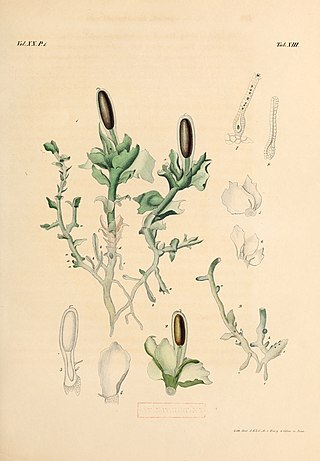
The Marchantiophyta are a division of non-vascular land plants commonly referred to as hepatics or liverworts. Like mosses and hornworts, they have a gametophyte-dominant life cycle, in which cells of the plant carry only a single set of genetic information.

Marchantiales is an order of thallose liverworts that includes species like Marchantia polymorpha, a widespread plant often found beside rivers, and Lunularia cruciata, a common and often troublesome weed in moist, temperate gardens and greenhouses.

Marchantiopsida is a class of liverworts within the phylum Marchantiophyta. The species in this class are known as complex thalloid liverworts. The species in this class are widely distributed and can be found worldwide.

Marchantiaceae is a family of liverworts in order Marchantiales. It contains a single genus Marchantia.

Jungermanniales is the largest order of liverworts. They are distinctive among the liverworts for having thin leaf-like flaps on either side of the stem. Most other liverworts are thalloid, with no leaves. Due to their dorsiventral organization and scale-like, overlapping leaves, the Jungermanniales are sometimes called "scale-mosses".

Calobryales is an order of plants known as liverworts.

Sphaerocarpales is an order of plants within the liverworts. Approximately twenty species are in this order which is sub-divided into four families: Monocarpaceae, Sphaerocarpaceae and Riellaceae, as well as the extinct family Naiaditaceae. The inclusion of the Naiaditaceae is uncertain, and the family has sometimes been assigned to the Calobryales.

Jungermanniopsida is the largest of three classes within the division Marchantiophyta (liverworts).

Haplomitriopsida is a newly recognized class of liverworts comprising fifteen species in three genera. Recent cladistic analyses of nuclear, mitochondrial, and plastid gene sequences place this monophyletic group as the basal sister group to all other liverworts. The group thus provides a unique insight into the early evolution of liverworts in particular and of land plants in general.

Blasiales is an order of liverworts with a single living family and two species. The order has traditionally been classified among the Metzgeriales, but molecular cladistics suggests a placement at the base of the Marchantiopsida.

Asterella is a liverwort genus in the family Aytoniaceae.

Haplomitrium is a genus of liverworts.

The APG IV system of flowering plant classification is the fourth version of a modern, mostly molecular-based, system of plant taxonomy for flowering plants (angiosperms) being developed by the Angiosperm Phylogeny Group (APG). It was published in 2016, seven years after its predecessor the APG III system was published in 2009, and 18 years after the first APG system was published in 1998. In 2009, a linear arrangement of the system was published separately; the APG IV paper includes such an arrangement, cross-referenced to the 2009 one.

Pelliales is an order of liverworts.

Pallaviciniales is an order of liverworts.

Fossombroniales is an order of liverworts.

Porellales is an order of liverworts.
Asterella gracilis is a thallose liverwort in the family Aytoniaceae.
Asterella bolanderi is a liverwort in the family Aytoniaceae. It is found in the undergrowth of chaparral habitat and on shady banks. Commonly found within Northern California at elevations lower than 3000 feet, its distribution also ranges along the coast into Southern California. Other members of the Asterella genus include A. californica and A. palmeri.

Mannia is a genus of liverworts belonging to the family Aytoniaceae. It has a cosmopolitan distribution.
















